Biomolecules and Nanotechnology
By David Goodsell
Evolution has forced innovative solutions to biomolecular problems. Some may inform the growing field of nanotechnology
Evolution has forced innovative solutions to biomolecular problems. Some may inform the growing field of nanotechnology

DOI: 10.1511/2000.23.230
The term "nanotechnology" commonly refers to a speculative field that proposes to build machinery so small its components are measured on a scale of billionths of a meter (nanometers) using many of the principles of macroscopic engineering.
In his books, K. Eric Drexler has popularized the design and computer modeling of many of these machines, including nano-scale manipulators to build objects atom by atom, bearings and axles built of diamond-like lattices of carbon, waterwheel-like pumps to extract and purify molecules and tiny computers with moving parts whose size is within atomic scale. The goals of these compelling machines are precision, with every structure and action controlled at the level of individual atoms, and parsimony, performing tasks at the minimum size necessary.
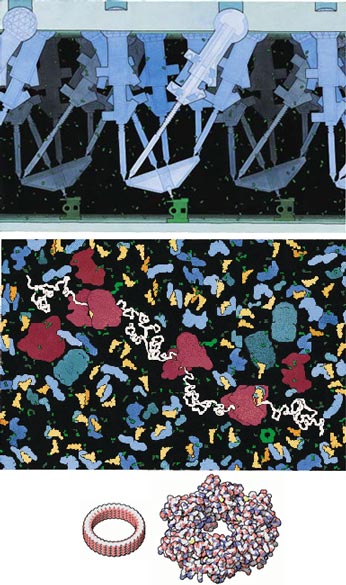
You might be surprised to learn that nanotechnology was perfected more than three billion years ago. Indeed, working examples of each of these machines exist today within living cells. Nanoscale manipulators for building molecule-sized objects were discovered by the earliest cells and are now used to build proteins and other molecules atom by atom according to defined instructions. Rotating bearings are found in many forms: Clamps that encircle DNA and slide along its length may be found in the simplest bacteria. Our own cells contain a rotary motor used not to power motion but instead to generate energy. Cells use a large collection of molecule-selective pumps to import ions, amino acids, sugars, vitamins and all of the other nutrients needed for living. Cells also use molecular computers, which, by altering their shapes, "read" the concentration of surrounding molecules and compute the proper functional outcome. By evolutionary search and modification over trillions of generations, living organisms have perfected a plethora of molecular machines, structures and processes. Figure 2 presents a few examples of the rich bio-nanotechnology that may be found in every modern cell.

Biological molecules are proven examples of the feasibility, and the utility, of nanotechnology. Our lives depend on them. They are foreign, however, to our everyday experience, with unusual organic shapes and unfamiliar properties. Bio-nanomachines are often the same size and complexity as the speculative nanomachines being designed today, but they bear little resemblance to the machinery of our macroscopic world. Eric Drexler's nanomanipulators and gears seem more familiar, because they are built by engineers along the familiar rigid, rectilinear designs of our macroscopic world. To understand the organic, flexible forms of bio-nanomachines, we must forget the processes of design and engineering in our familiar world and look instead at the forces that shaped the evolution of life.
The process of evolution by natural selection places strong constraints on the form that biological molecules may adopt. Because genetic information is passed directly from generation to generation, cells must maintain a living line back to the earliest primordial cells. If a cell fails to generate a living descendent, all of its biological discoveries will be lost. This is far more limiting than the technology of our familiar world. If we create machines that don't function, we scrap them and go back to the drawing board. But if a cell takes a gamble and changes a critical machine, it had better get it right the first time or the result will be disastrous.
The picture is not entirely grim, however, as cells have several levels of redundancy within which to develop new machines. First, the plans for a given machine may be duplicated, which allows the duplicate to be modified and ultimately perfected to perform a function different from the original. This is very common in the evolution of life. Hemoglobin, the protein that carries oxygen in our blood, is an example. Our cells contain information for building several different types of hemoglobin. One is optimized for carrying oxygen in the blood of adults, whereas another is found in the blood of a fetus. The fetal hemoglobin has a higher affinity for oxygen, allowing it to capture oxygen from the mother's blood. About 200 million years ago, a gene duplication allowed the fetal hemoglobin to be perfected separately.
Second, biology seldom involves a single cell. A population of cells?billions, trillions?is the biologically relevant entity. Within this population there exists ample room for experimentation. Millions of modifications may be tried, even if most are ultimately lethal. The population will still survive and individuals with rare improvements may grow to dominate in later generations. Human immunodeficiency virus (HIV) shows the benefits of evolutionary change, accelerated so that we can see the effects in months instead of millennia. HIV reverse transcriptase, the enzyme that copies the virus's genetic information, is particularly error-prone. Because of this, the population of viruses within an infected individual contains viruses with all possible single-site mutations?thousands of variants on the wild-type virus. The best of these will dominate, but even the weakest are continually created and recreated in subsequent generations by the low-fidelity copying mechanism. Thus, when an infected individual is treated with anti-HIV drugs, the population has a wide range of different mutants to choose from, some of which may be resistant to the drug: The virus is made more efficient by its very inefficiency.
The hallmark of biological evolution is the plasticity provided by mutation and genetic recombination. Within a population, or through genetic duplication within a single cell, a great many variants may be tested and the occasional improvement saved.
Evolution carries with it one important drawback, however: the problem of legacy. Once a key piece of machinery is perfected, it is difficult to replace it or make major modifications without killing the cell. This is particularly true for major molecular processes, such as protein synthesis, energy production and reproduction, which require the concerted action of many different molecular machines. This leads to the remarkable uniformity of all earthly living things when observed at the molecular level. All are built of the same basic components.
As a consequence of the evolution of life from a single primordial cell, all known living things on earth share a common molecular plan. All living things are made of four basic molecular building blocks: protein, nucleic acid, polysaccharide and lipid. Other small molecules are specially synthesized for specific functions, but the everyday work of the cell is performed by the four basics. The earliest cells chose these materials to the exclusion of others, and subsequent generations of cells, right up to our own, have been forced to work with them.
Two different approaches are taken to synthesize these molecules, resulting in characteristic forms and functions. Proteins and nucleic acids are built in modular form by stringing subunits together based on genetic information. Proteins and nucleic acids may be built in any size and with subunits in any order. This gives remarkable flexibility to the form and function of these molecules.
In contrast, lipids and polysaccharides are built by dedicated machines. Each new type of lipid molecule requires the creation of an entirely new suite of synthetic machines. Likewise, a new suite of machines must be created to build each new type of polysaccharide linkage. The result is that lipids and polysaccharides appear in fewer forms than proteins and are used in much more limited, albeit essential, roles.
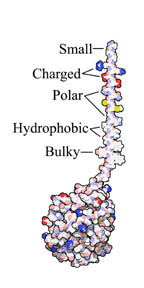
Our distant relatives developed a standard for biological information, choosing a particular 20 amino acids to be used in proteins, encoded by five types of nucleotides found in the nucleic acids DNA and RNA. Today, every protein is made of these 20 amino acids (at least initially). In their defense, these primordial cells chose an excellent set of building blocks, including flexible and rigid components, charged, uncharged, acidic, basic and neutral amino acids, large and small amino acids, and several with attractive chemically reactive properties (Figure 3). The amino acids may be used to create proteins with a wide range of properties. These include very flexible proteins with changeable shapes and very rigid cross-linked proteins designed to retain their shape under harsh conditions. Other proteins are highly basic or highly acidic, designed to perform their jobs under extreme acidic or alkaline conditions. Some are covered with carbon-rich groups that repel water and seek out membranes for binding; others have polar surfaces and perform their duties in the watery cytoplasm.
Modular synthesis allows proteins to be built in many shapes and sizes. As a consequence, most of the processes of modern cells are performed by proteins. Evolutionary legacy, however, places several limits on the design of proteins. As noted above, proteins are limited to the 20 components encoded in the DNA genome. Evolution also limits the size of proteins, limits them to aqueous environments and requires that they automatically assemble themselves within the crowded confines of the cell. In spite of these limitations, the breadth of protein form and function in modern cells is remarkable.

The size of a protein is limited by the error rate of the protein-synthesis machinery, which in theory could produce a protein of any length. Missense errors, which misread the genetic information and substitute an incorrect amino acid at one position, occur at an average frequency of about 1 in 2,000. For a protein composed of 500 amino acids, one out of four proteins will typically have an error, but nearly every protein of 2,000 amino acids will have one. More important, however, are processivity errors, which cause protein synthesis to abort prematurely. These errors have been estimated to occur at a rate of about 1 in 3,000, so long proteins of several thousand amino acids are only rarely constructed in full. The average size of a typical protein chain, 300 to 500 amino acids, is the compromise adopted by most cells. Error rates keep the chain length low, so larger proteins must be built as complexes of multiple protein chains.
Proteins were invented in "warm, salty pools," so life on earth now requires a warm, aqueous environment (either externally or carried around inside). Water is essential for protein structure and function because of an emergent property of water solutions, termed the hydrophobic effect. Water has peculiar properties, which are used to great advantage by biological molecules. Portions of a protein that are rich in carbon interact weakly with water and are termed hydrophobic. When placed in solution, these hydrophobic regions crowd together in a globule, minimizing contact with water and allowing the water to escape and interact with more favorable environments. The hydrophobic effect is a major stabilizing force for protein folding, where carbon-rich portions of the chain are folded within the protein globule (as well as for formation of the lipid membranes that surround every cell, where the carbon-rich portions of the lipids are packed inside the membrane). Because our molecules rely on hydrophobicity for their structural integrity, we could never live in vacuum or in organic solvents. Our proteins simply would not fold.
Perhaps the most difficult limitation to overcome is the need for self-assembly. Biological molecules are designed to assemble themselves within cells: Proteins are created as unstructured, linear chains of amino acids that must fold into a stable, functional conformation (sometimes with a little chaperoning in the proper direction). Often, the folded chain spontaneously associates with others to form larger stable complexes. This is a major limitation to the design of proteins: Not only must the protein be functional in its active conformation, but the protein chain must also be designed to fold into this active conformation using only the folding tools available in the cell.
The forces involved in biomolecular structure and interaction are different from those at play in the macroscopic world, and thus our intuition may play us false when attempting to understand protein self-assembly. In our macroscopic world, much of engineering is based on the effect of gravity on solid objects. The strength of concrete and steel and the different frictional properties of Teflon and rubber are familiar quantities.
The molecular world, on the other hand, is dominated by the effect of thermal motion on the atomic interactions within and between molecules. Molecules are endowed with kinetic energy proportional to the temperature, which manifests itself as translational, rotational and vibrational motion. The forces holding molecules together are continually fighting against these motions and are often overcome by them.
The cellular environment is unusual in another respect, as shown in Figure 4. Proteins are synthesized in cells and left to float freely, diffusing to their ultimate site of action amid a crowded collection of competitors. Thus, a typical protein will come into contact with thousands of other types of proteins and must be able to discriminate its unique target from all others. This is quite different from the macroscopic world, where an engineer can selectively fit two parts together. For instance, the concept of a #6 screw would never work inside the cell. When building a chair, we are able to use the same screw to fasten many different pieces together, because we actively choose where each goes. In the cell, however, each molecule must be designed with a unique fastener, ensuring that it binds only to its proper target and no other.
Before atomic structures of proteins were known, physicist H. R. Crane provided two design concepts that are required for biological self-assembly. First, "for a high degree of specificity the contact or combining spots on the two particles must be multiple and weak." An array of many weak interactions, such that all are needed to provide the necessary stability, will form a specific site for interaction. If only a few very strong interactions are used, there is an increased chance that a protein will find a similar interaction with improper proteins.
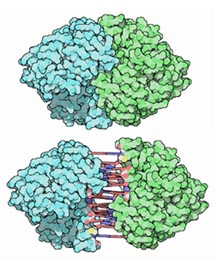
Second, "one particle must have a geometrical arrangement which is complementary to the arrangement on the other." In other words, the shape of the interacting surfaces must form a good fit, and this fit must be different from that with other proteins. Specificity is provided by the complementary shape of the interacting surfaces, fitting knobs into holes, and by the complementary arrangement of hydrogen-bonding groups and charge-charge pairs. These two principles?that protein-protein interfaces are extended, with many weak interactions, and that protein-protein interfaces are complementary?have been proved in numerous protein structures, such as the one shown in Figure 5.
The process of evolutionary selection has yielded an unusual result: Evolution of proteins favors perfect symmetry. The majority of soluble and membrane-bound proteins found in cells are symmetrical complexes formed by several subunits. Most proteins are oligomeric, composed of multiple copies of one or more types of subunits. Nearly all of these oligomeric proteins are also beautifully symmetrical, with identical subunits packed in identical environments. A complex interplay of conflicting functional needs has driven evolution to this surprisingly aesthetic conclusion.
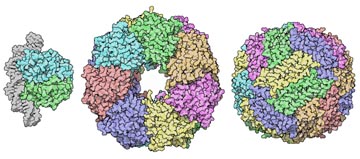
The major evolutionary force is the need for large proteins. Large proteins are preferred over smaller proteins and peptides for several reasons. Some functional roles simply require a molecule that is physically big. Large protein complexes form structural elements that span entire cells; they form rings that encircle DNA and rulers that measure lengths of DNA; they create pores of many sizes through cell membranes; they form large spherical containers for storage and delivery and small cylindrical containers that create exactly the proper environment for protein folding.
Large proteins are also well suited for cooperative functions, such as allostery (discussed below) and multivalent binding, which require a molecule with several identical active sites. Multivalent binding increases the binding strength of a molecule to a target by reduction of entropy. Once one site on the protein has bound, the other sites are held in close proximity to the target, increasing their probability of binding. Many of the molecules of the immune system have a distinctive shape, composed of many flexible arms, in order to take advantage of this cooperativity.
Large proteins also have attractive physicochemical characteristics. They are more stable against denaturation, having a more stabilized internal structure than small proteins. Large proteins also have a lower ratio of surface area to volume, making them less prone to damage and degradation by other enzymes.
Unfortunately, the accuracy of the protein-synthetic machinery limits the size of proteins that may be constructed. As noted above, protein chains of 300 to 500 amino acids may be consistently synthesized, but longer chains will become increasingly riddled with errors. The answer is to build a complex from subunits when a large protein is needed, which allows any faulty subunits to be discarded. This also allows new possibilities for regulation: Large structures may be built and disassembled at will, or subunits may be transported to a distant site (or even outside the cell) and assembled there.
Nearly all of these oligomeric proteins in cells form closed, symmetrical complexes based on ideal point-symmetry groups. In general, if a complex contains several identical subunits, they will adopt identical symmetrical positions in the complex. Asymmetric complexes and random aggregates are almost completely unknown. Symmetrical association is favored over asymmetric association because it provides stability and control. The stability of closed, symmetrical complexes is a consequence of two factors. First, interfaces between proteins are highly specific and highly directional, so in most cases evolution selects and improves only a single type of association between subunits. Second, given these specific, directional interfaces, the maximum number of intersubunit contacts is formed by closed complexes.
Closed, symmetrical complexes also ensure that the level of oligomerization is tightly controlled. Unwanted aggregation is very dangerous for cells?pathological aggregation of mutant proteins leads to diseases such as sickle-cell anemia, Alzheimer's disease and prion-related diseases. Selection of a closed, symmetrical complex defines the size and shape of the resultant complex.
Under special circumstances, symmetry may be broken for a given functional need. For instance, viruses often need to build shells that are too large to construct with typically sized proteins in perfect symmetry?the highest point-group symmetry is icosahedral, so the largest perfectly symmetrical capsid is limited to 60 subunits. If larger shells are needed, more subunits must be used.
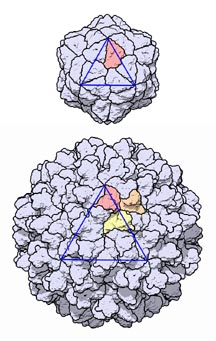
Viruses often turn to quasisymmetrical complexes, where hundreds to thousands of identical subunits combine in similar, but not perfectly symmetrical, positions. Quasisymmetry was first conceived as a method of tiling an icosahedron with a triangular network, much like the geodesic domes designed by Buckminster Fuller. Protein subunits are arranged in this triangular lattice. Small elastic deformations allow the subunits to adopt similar contacts in each of the different positions. A series of different networks can be defined containing 60T subunits, where T is a "triangulation number." Only certain triangulation numbers yielded smooth networks, according to the relation T = h2 + hk + k2, where h and k are integers.
When structures were obtained for viral capsids, this model for quasiequivalence was surprisingly successful. The arrangement of subunits of most capsids corresponded closely to one of the triangulation numbers: Examples with T = 1 (perfect icosahedral) symmetry and T = 3 symmetry are shown in Figure 7. However, elastic deformations were not observed. Instead, subunits typically accommodated different positions through the use of structural "switches," where the subunit adopts two or more significantly different conformations. Often, the subunits are composed of two domains connected by a flexible linker, and flexure of the subunit is used to adopt different conformations.
Engineers in our macroscopic world typically build rigid structures that stoically resist the forces of nature. Nature, however, has taken a different approach, developing machines that flex over the course of their action. Is a totally rigid nanostructure needed or even desired? Apparently not. In fact, biological molecules take advantage of flexibility for many aspects of their function. Many of these functions would be severely compromised, or not even possible, given a rigid molecule. Subtle motions can have surprisingly large effects on reaction rates or assembly. Biological molecules are perfectly placed to take advantage of these subtle motions. The step-by-step optimization provided by evolution allows a moderately active protein to be improved, through small changes modifying structure and flexibility, to yield a machine ideally tailored to fulfill its function.
This process is easy for evolution but far more difficult for biotechnological design. We design our machines in one step, instead of through many small random optimization steps, and we expect to get it right with a minimum of tweaking and redesign. Thus, to anticipate all of the subtle effects of motion, our design techniques must be accurate enough to predict conformation and flexibility of molecules at scales far smaller than the radius of an atom.
All biological molecules are flexible to some extent and are battered into different conformations by the constant pressure of surrounding water and the kinetic energy of their own atoms. At physiological temperatures, biological molecules constantly flex. Most of the interactions holding a protein together are conserved?covalent bonds remain connected, hydrogen bonds and salt bridges link portions of the chain?but entire elements of secondary structure flex, bending slightly or separating momentarily from the globule. These motions are often termed "breathing." Breathing is essential in the function of myoglobin, a deep red protein that stores oxygen in muscle cells. Oxygen is bound to myoglobin in a pocket that is completely buried within the protein. Looking at the static structures provided by x-ray crystallography, there are no channels leading into or out of the pocket. For the oxygen to enter and exit, the molecule must breathe, transiently forming channels that allow passage.
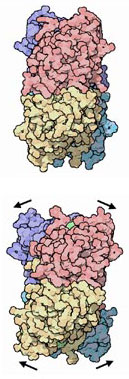
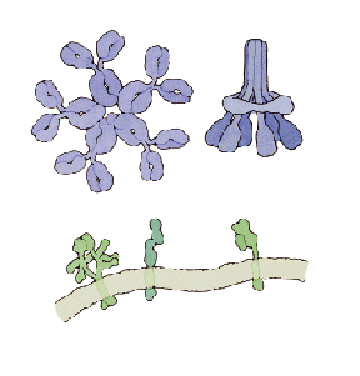
Many proteins use a carefully designed change of shape to regulate their action. These allosteric ("other shape") proteins are composed of several subunits, each of which performs identical functions. In the simplest model of their action, each subunit may adopt two conformations, one functionally active, the other less active. Regulation is performed by propagation of the shape change from one subunit to its neighbors. For instance, phosphofructokinase, a key enzyme in sugar metabolism, uses allosteric regulation to modify its action. Phosphofructokinase is composed of four identical subunits (a tetramer), each containing a reactive site for the sugar molecules. The tetramer also contains binding sites for the energy molecule adenosine triphosphate (ATP) in the cleft between subunits. When ATP binds to this second site, it forces the entire enzyme complex into a different shape, which is less active than the original form. In the cell, this regulation is used as a negative-feedback loop. ATP is one of the final products of the sugar-breaking process that the enzyme performs. When ATP is plentiful, it binds to the regulatory site in phosphofructokinase, shutting down its own synthesis. The enzyme that performs the opposite reaction, shown in Figure 8, is also allosterically regulated.
Many protein chains rely on "induced fit" to mediate their function. The chain may remain in a partially unfolded conformation that only completely folds when it binds to its target. Induced fit may be used to create doorways that allow ligands to enter protein cavities that are shielded from the surrounding environment. HIV-1 protease is an example. The active site is a cylindrical tunnel, with the cleavage machinery at its center. Somehow, a polypeptide must be threaded through this tunnel in order for the cleavage reaction to occur. This problem is solved through the use of two flexible flaps that cover the top of the tunnel. When free in solution, these flaps are disordered, opening a path to the active site. When the protease wraps around its target, the flaps close, forming a stable structure that positions the polypeptide accurately for cleavage.
Flexible linkages are common in the molecular world. Protein chains may be made more flexible through addition of many molecules of the amino acid glycine, which are less hindered in bond rotation because of the lack of a side chain, or through addition of many charged residues, which favor exposure to solvent over forming a compact globule. The rigid kink formed by proline, surprisingly, is also commonly found in flexible regions, because it does not fit comfortably within compactly folded structures. The immune system contains many examples of flexible linkages that enhance multivalent binding, as shown in Figure 9.
Biological molecules are examples of solved problems in nanotechnology?lessons from nature that may be used to inform our own design of nanoscale machines. The entire discipline of biotechnology has emerged to harvest this rich field of biological wealth. We routinely edit and rewrite the information in DNA to build custom proteins tailored for a given need. Today, for instance, bacteria are engineered to produce hormones, genes for disease resistance are added to agricultural plants, and cells are cultured into artificial tissues.
Principles of protein structure and function also yield insights for nanotechnological design and fabrication. The diversity of protein structure and function shows the power of modular, information-driven synthesis, as well as the limitations imposed by modular design once a dedicated modular plan is chosen. Proteins demonstrate that extended, complementary interfaces are essential prerequisites for molecular self-assembly. The prevalence of protein complexes proves that error-prone synthesis may be accommodated through the use of subunits and symmetry to build large objects accurately and economically. And contrary to our macroscopic experience, motion and flexibility may be assets, not liabilities.
The principles observed in the mobile, organic shapes of biological molecules may be applied to the controlled rectilinear forms of diamondoid lattices, fullerines or whatever nanoscale primitives are ultimately successful. We must not be too impatient, however. Nature has had some three or four billion years to perfect her machinery; so far, we have had only a few decades.
Click "American Scientist" to access home page
American Scientist Comments and Discussion
To discuss our articles or comment on them, please share them and tag American Scientist on social media platforms. Here are links to our profiles on Twitter, Facebook, and LinkedIn.
If we re-share your post, we will moderate comments/discussion following our comments policy.